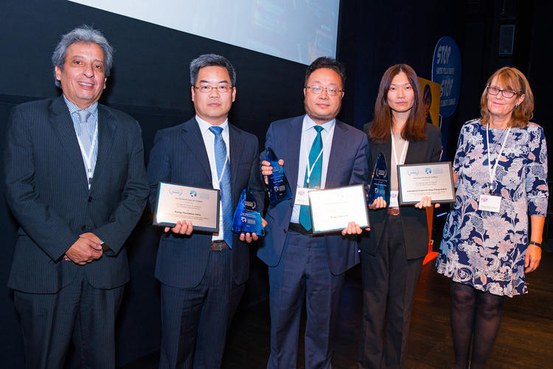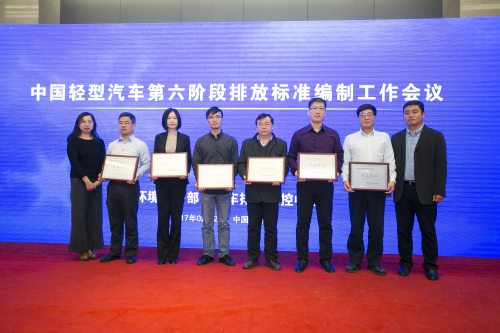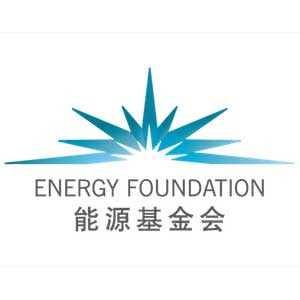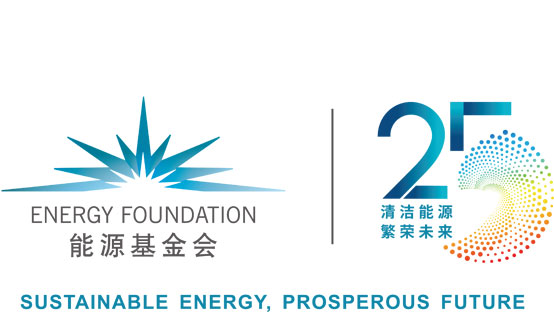Improved Standards Give Birth to Cleaner Cars in China
In September 2018, Mr. Gong Huiming, representing Energy Foundation China, went up the podium in San Francisco for the 2018 Climate and Clean Air Awards and received the Transformation Policy Award from the United Nations Environment Programme. “This is an important recognition of EF China’s efforts on helping China in launching the world’s most stringent emission standard for heavy-duty vehicles (China VI) and its national campaign on clean diesel engine. It is also a reflection of our efforts to reduce automobile pollutants in China,” said Mr. Gong, director of the foundation’s transportation program.

EF China received the 2018 Climate and Clean Air Awards from the Climate and Clean Air Coalition of the United Nations Environment Programme (UN Environment)
Photo Courtesy by Climate and Clean Air Coalition of the UNEP
For the last 20 years, EF China has been steadfast in its support for the constant improvement and tightening of China’s automobile emission standards and fuel quality standards. Today, China has some of the world’s most stringent standards on auto emission. And fuel quality in the country has been greatly improved with decreasing sulfur content, thus finally achieving integrated management over vehicles and fuel.
From China I to China VI, a Follower Turned Into a Leader
In the early 1980s, very few people could foresee that the bicycle kingdom’s “reform and opening up” was going to create the world’s largest market for automobiles, let alone doing so in such a short period of time. Back then, China issued a series of emission standards regarding automobile exhaust. However, due to a lack of experience, the earliest standards did not form a cohesive system. Since the late 1990s, the country has chosen to learn from European experiences in this area. In 2001, the China I Emission Standards for Light-duty Vehicles was issued, imposing numeric limits over the emission of carbon monoxide, hydrocarbons, nitrogen oxides, and particulate matter. Since then, the country has had an effective system of vehicle emission standards with a process of continuous update.

2001年颁布的“国一标准”
With China I as a starting point, EF China has helped introduce international experiences and promote continuous improvement of automobile emission standards. Under its support, Michael Walsh, the former Deputy Assistant Director of the U.S. Environmental Protection Agency for mobile source pollution control, and the International Council on Clean Transportation (ICCT) have assisted the Ministry of Ecology and Environment (MEE, and its predecessors the Ministry of Environmental Protection and the Environmental Protection Administration), its research institution Vehicle Emission Control Center (VECC), and the Environmental Standard Institute (ESI) of the Chinese Research Academy of Environmental Sciences over technology, management, and strategic consulting services related to vehicle emission control. It has provided significant support to the China-U.S. Motor Vehicle Pollution Prevention and Control Forum by inviting international experts to conduct in-depth dialogues in China, and organizing Chinese experts on academic visits, exchanges, and training to the United States and Europe. In 2010, EF China extended valuable support to the city of Beijing in carrying out a feasibility study of the Beijing V Emission Standard, introducing advanced international practices and propelling the city to upgrade its emission standard in 2013. Later, this experience helped provide a useful lesson for the tightening of the national standard.
With the collective research contribution of the VECC, the ESI, the now defunct Beijing Automotive Research Institute, Tsinghua University, and the China Automotive Technology and Research Center, the country has completed an incredible upgrade of vehicle emission standards, eventually catching up with the most advanced in the world in merely 16 years. At the same time, China has developed into the world’s largest automobile market. In 2018, the total number of automobiles on the road in China reached 240 million, thus making auto pollutants a major source of air pollution in many big cities in the country. This has really lent added urgency to the work of establishing more stringent emission standards which will play a key role in guiding the automotive industry to eliminate weak and polluting enterprises and reversing the increasingly severe air pollution. In the end, it will contribute toward efforts on fighting global climate change.
In 2014, Energy Foundation China provided support to the VECC in launching pre-research on the China VI standard based on actual conditions on the ground throughout the country. This work provided the earliest research recommendations for the formulation of the new standard. Then, the MEE decided to entrust the VECC to organize various stakeholders from the auto industry to help draft the China VI standard. This is the first time that an environmental research institution became the leading organizer for drafting a vehicle emission standard.

During its research process, EF China had been made keenly aware of the importance of participation by the auto industry in terms of the formulation and implementation of standards. Therefore, it had often pushed for inviting auto businesses to participate in the research and discussion. In the end, representatives of automobile companies participated in all six research groups of the China VI standard, even taking up leading roles for some research items. This created favorable conditions for building consensus between environmental regulators and automobile companies and laying down foundation in advance for future enforcement.
Under the joint efforts, China launched China VI, its first vehicle emission standard uniquely suited to the local conditions in the country. As part of it, China VI for light-duty vehicles was released at the end of 2016 and due to be implemented on July 1, 2020; China VI for heavy-duty diesel vehicles was released in June 2018 with implementation starting on July 1, 2019. Recommendations supported by EF China, such as improvement in testing and procedures, enhanced control over actual road emissions and evaporative emissions, and requirements on particulate matter concentration, were adopted as part of the standard. Compared with China I back in 2000, the latest standard will reduce emission of nitrogen oxides and particulate matter per vehicle by 96 percent and 98 percent respectively for light-duty vehicles, and by 94 percent and 97 percent for heavy-duty vehicles. This makes it one of the most stringent auto emission standards in the world. China has completed this significant upgrade from almost non-existent to world-leading in less than 20 years. By comparison, the U.S. took 30 years to complete this process.
In February 2017, the VECC presented the “Outstanding Contribution Award for the Establishment of the China VI Emission Standard for Light-Duty Vehicles” to EF China. “The foundation has been responsible for providing an innovative insight, a rich international experience, and a platform for multi-disciplinary dialogue from planning to research, laying important foundations for the smooth development and implementation of the standard,” said Ding Yan, deputy director of the VECC.

EF China received prestigious award from the Vehicle Emissions Control Centre of the Ministry of Environmental Protection
Photo courtesy by Vehicle Emissions Control Centre
A Synchronization of Fuel Standards and Emission Standards
When it comes to auto emission, fuel quality is often the key. In advanced economies, fuel quality standards and emission standards are often updated and implemented simultaneously. In China, fuel standards had lagged behind emission standards for a long time. Specifically, the lag for gasoline is about two years, and three to four years for diesel. This had seriously delayed the upgrading of emission standards and held back the country from meeting its targets on emission reduction.
In this area, the most important thing is that the rate of reduction of sulfur content in fuel standards should be consistent with requirements of emission standards. Since 2004, EF China has promoted desulfurization in fuel products. However, the industry was worried about related costs, which had caused significant resistance. In 2005, EF China supported an International Symposium on Desulfurization of Automotive Fuel and a report titled “Costs and Benefits of Reduced Sulfur Fuels in China.” The report stated that implementation of both auto emission standards and low-sulfur fuel standards could achieve maximum environmental and public health benefits with minimal cost, as the cost of reducing sulfur content would be shared by both businesses and consumers. For the next seven years, EF China provided support to a series of economics and cost related research and seminars, actively prodding all parties concerned to exchange views on low-sulfur fuel technology and related cost issues. In September 2013, the National Development and Reform Commission issued a financial policy for the upgrade of fuel quality in China, which was based on the principles of reasonable compensation to increased cost, higher price for higher quality, and polluter made to pay for damages. It set the tone for price increases under the upgrading of gasoline and diesel standards and paved the way forward for the upgrade of fuel products from China III to China IV and V fuel quality standards.

When promoting the desulfurization of fuel products, EF China came to the realization that one urgent issue that needed to be dealt with was the so-called synchronization of fuel and emission standards, which is about the difficulty to incorporate the increasingly stringent emission requirements into the formulation of fuel quality standards in a timely manner. This is due to the fact that emission standards and fuel standards are handled by different government departments separately in charge of the environment and petrochemicals. Since 2008, EF China has provided support to the learning of international experiences and presented analysis on the necessity and feasibility of the synchronization. In addition, it called upon the fuel agencies to reach out to environmental experts in its process of research and discussion, and take into account of the needs on the emission side. EF China also provided opportunities for dialogue, communication, and cooperation between the environmental sector and the petrochemical industry in its projects. Through all these efforts, it managed to facilitate the petrochemical industry and the environmental sector in interacting with each other, thereby providing favorable conditions for fuel standards to catch up with the pace of advancing emission standards.
Since 2017, the country has implemented China V standard on gasoline and diesel, with the sulfur content limit at 10ppm, which is 93.7 percent and 99.5 percent lower than the corresponding requirements of the China III standard in 2009. This means that it only took eight years for China to achieve the goal of fuel quality leapfrog, from falling far behind Europe and the U.S. to drawing level with Europe and pulling ahead of the latter. At the same time, the new fuel standard was finally released simultaneously with updated emission standards on a national level, thereby achieving the goal of synchronization. The latest China VI standard for gasoline and diesel implemented in 2019 is another big improvement from its predecessor China V, further tightening the restrictions on olefins and vapor pressure.

Today, China has the world’s most stringent auto emission standards and toughest auto fuel standards, but this is merely the beginning of another long march. “In the future, EF China will continue to push the second largest economy to establish a more stringent regulatory system for vehicle emission, in order to ensure supervision of compliance and effective enforcement of the standards,” Mr. Gong said.



